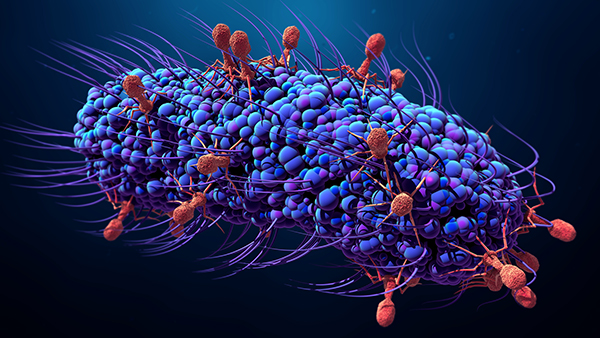Because CRISPR news tends to focus on the applications of genome editing—such as treating genetic diseases or improving food—it may be easy to forget that the system is, at its core, used by bacteria to defend themselves from phage infections. To achieve immunity, CRISPR (and restriction-modification systems) target and degrade DNA.
But over the past decade, since the time of CRISPR’s discovery, many other, diverse, antiviral systems have been identified in bacteria. One example, defense-associated reverse transcriptases (DRT) systems, take advantage of DNA synthesis, not cleavage. But how DNA synthesis leads to antiviral defense has remained largely unknown.
Now, new work from the lab of Sam Sternberg, PhD, associate professor of biochemistry and molecular biology at Columbia University and an HHMI Investigator, describes the mechanism of antiviral immunity used by a DRT. The findings show that the DRT achieves population-level antiviral immunity via cellular growth arrest. More specifically, upon phage infection, reverse transcriptase synthesizes genes whose protein products help shut down cell growth.
This work is published in Science in the paper, “De novo gene synthesis by an antiviral reverse transcriptase.”
The paper is unexpected, mechanistically, and thought-provoking, notes Rodolphe Barrangou, PhD, professor of Food Science at North Carolina State University. He adds that it expands the phage resistance arsenal, specifically on the growth arrest front (because the host aborts growth more than becomes resistant per se).
“Many bacterial immune systems function in an altruistic sense, by killing or arresting growth of the infected cell, to save the broader population,” added Sternberg. “While this phenomenon has been carefully studied by many other groups, our work uncovers a brand new mechanism of this kind of altruism, in which the growth arrest is specifically triggered by the creation of a new, de novo gene, that we call neo.”
The DRT family was first identified four years ago in the lab of Feng Zhang, PhD, professor of neuroscience at MIT and an HHMI Investigator. The discovery was published in Science, in the paper, “Diverse enzymatic activities mediate antiviral immunity in prokaryotes.”

The Sternberg lab sought to understand the mechanism underlying the DRT systems’ activity. Using Klebsiella pneumoniae, the researchers, led by graduate student Stephen Tang, first revealed that the reverse transcriptase binds to the ncRNA region (upstream of the RT gene in the DRT system) to make the corresponding cDNA. Not only did phage infection increase the levels of cDNA, but phage infection also drove second-strand synthesis, generating a double-stranded DNA. Even more remarkably, sequence analysis uncovered that the cDNA products were concatenated repeats, and that they were present only in the presence of phage. Long-read sequencing done using Oxford Nanopore Technology (ONT) revealed that the cDNAs can be up to multiple kb in length and include many copies of the 120 bp repeat. The team concluded that the reverse transcriptase is performing rolling-circle RT activity.
But how does that lead to cell arrest? The group was one step closer to answering that question when the data suggested that the DNA was transcribed into concatenated RNA that encoded a gene. The gene, which the researchers named Neo (never-ending ORF), produced the Neo protein. Upon phage infection, the Neo protein was expressed, and growth was arrested.
“The interesting aspect of this work,” Barrangou asserts, “is the RNA-based neogenesis of genetic material, which is challenging the unidirectionality of the central dogma of biology. More dogma evolving than dogma challenging, but very intriguing. This reminds us of why we have to study host-viral interplay to unearth novel genetic mechanisms.”
“This project opened our eyes to the presence of cryptic, hidden genes that are deployed to specifically combat viral infections during a bacterial immune response,” noted Sternberg. “A powerful and widespread family of enzymes, the reverse transcriptases, create these genes from noncoding RNAs, and we’re now busily hunting for more extra-chromosomally encoded genes that might be generated in other types of cells and organisms, including humans.”
Some questions that the group will continue to ask are: how do the Neo proteins induce arrest? How is phage infection sensed? How conserved is this method?
But Sternberg noted that this work goes beyond just this one system in Klebsiella or even bacteria. He added that the mechanism, and the concatenation specifically, challenges our assumptions about gene annotation and gene size. It also challenges traditional inheritance models, because Neo is produced extra-chromosomally. Lastly, he asserts that it challenges the central dogma itself, given that the neo gene is both reverse transcribed and then transcribed back into RNA.
The lab, Sternberg explained, is “dying to find examples of this mechanism outside of DRT systems, and even outside of bacteria. Retroelements and reverse transcriptases are broadly found across all three domains of life. Imagine that you have reverse transcriptases in human cells, making non-linear concatenated forms of cDNA that have function that couldn’t be predicted by looking at the linear sequence of the genome.” That is the idea, he said, that keeps him up at night.
Sternberg presented this work at GEN’s “The State of CRISPR and Gene Editing” Summit, which took place earlier this year, in June. You can register for free to watch the talk here.


